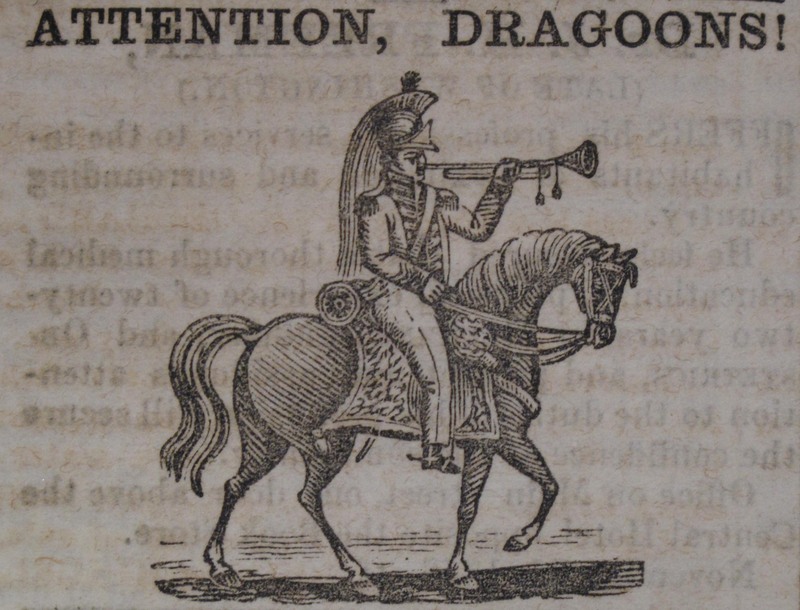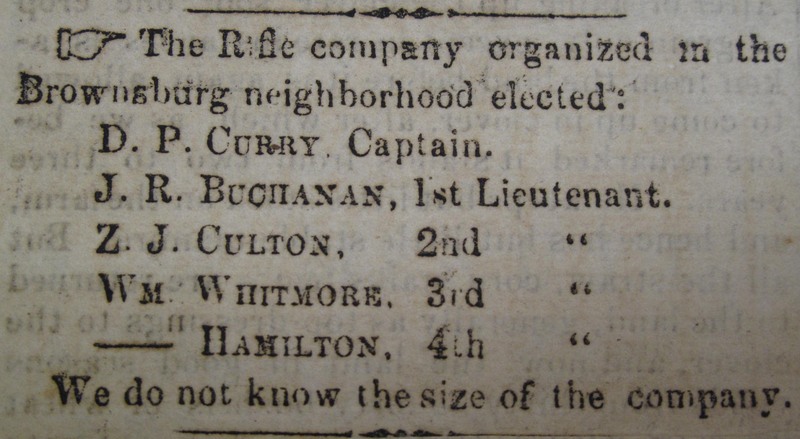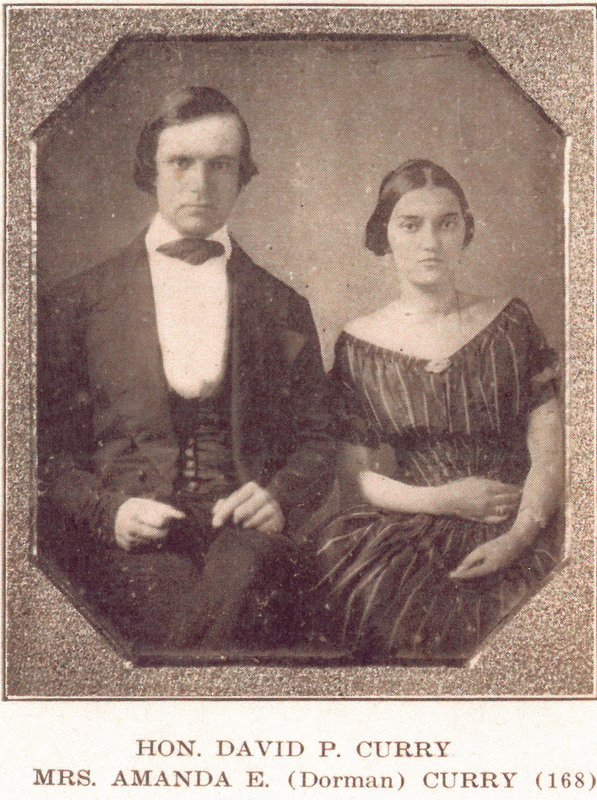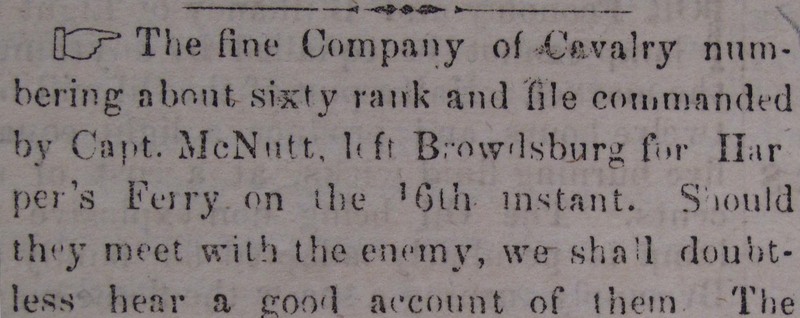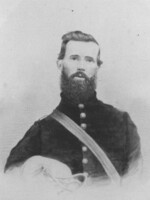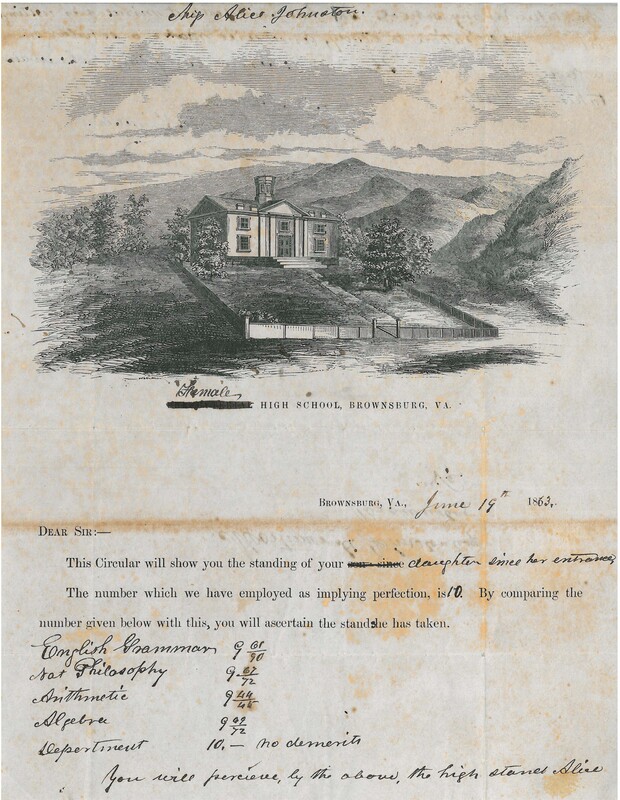And so Brownsburg went to war. Even before the month of April passed, the eager young men of the village and its environs had formed two military companies, the Second Rockbridge Dragoons, which became Co. H, 14th Virginia Cavalry, and the Rockbridge Guards, enrolled for state service as Co. H, 25th Virginia Infantry. A handful of Brownsburg men enlisted in other Rockbridge companies.
Girding for War
They rode and marched away bearing names like Patterson, Beard, Firebaugh, Sterrett, Bare, Moneymaker, Chittum, Sandridge, Swisher, Miller, Moore—names still evident among Brownsburg-area residents today. The Guards left for Staunton May 5, following a prayer service at New Providence and outfitted in “complete uniform” of Confederate gray with appropriate accoutrements.
In just over a week, according to a writer in the Lexington Gazette, the ladies of Brownsburg and vicinity had “made 80 coats, 80 pants, about 140 fatigue shirts, 80 knapsacks, 80 haversacks, 80 cloth caps, . . . covered 80 canteens with cloth, and [made] ten tents” for the company. The Dragoons as well were soon in the field; both units saw hard service in the summer of 1861 in the Confederates’ losing effort to defend the Alleghany Mountains in what would become in 1863 West Virginia. On June 2 the Dragoons were involved in a small engagement at Philippi; soon after they were advertising in the Gazette for additional “brave men and fearless riders.” All they required of prospective recruits was “a good horse and a double-barrel shot gun.”
The first Rockbridge County resident to give his life for the Confederacy was a Brownsburg man, Lt. Robert McChesney of the Dragoons, killed in a skirmish June 29. The Guards suffered their first casualties at the Battle of Rich Mountain on July 11.
On the home front, a home guard of the very young and elderly was formed, initially captained by Henry Boswell Jones of White Hall, a farm on the Goose Creek (then called Sugar Creek) road a mile from town.
Area women organized the New Providence Soldiers Aid Society to systemize the local effort “to contribute to the comfort of the soldiers engaged in the defence [sic] of our country”; the 170 members, organized into four districts of which Brownsburg was one, pledged their time and handwork, or else money or bought materials, on a continuing basis. District meetings occurred every two weeks, and a general meeting was held monthly to hear progress reports and arrange for distribution of the items collected. 57 men became honorary members through a contribution of $2.00 or more. In the words of Katharine L. Brown from her book New Providence Church: A History, 1746-1996:
"The projects undertaken by these women were remarkable. In October [1861], they made clothing for the Rockbridge Guards. They adopted a soldier, Mr. Vears, an exile from Wheeling on the Ohio River, who had joined the Rockbridge Artillery, and made all his clothing and bedding. The Brownsburg committee appropriated thirty-five dollars to buy material to make clothes for the Upshur Grays, and cut out and distributed to members six pairs of pants, six jackets and eight pairs of drawers to sew. Clothing went to Colonel Hansboro’s Brigade from North Western Virginia. Boxes of food, bedding, medicinal herbs and bandages were regularly sent to army hospitals, at Big Springs, Warm Springs, Staunton, and the Valley Mountain Hospital. On October 23, the twenty women present at the Newport district meeting made one soldier’s overcoat, two comforts, fifteen handkerchiefs and five pairs of gloves. At one meeting of the Rock Castle district, the directress recorded the individual donations of provisions to send to one of the hospitals:
| 2 loaves bread, cakes & sage | Mrs. McNutt |
| 1 cheese | Mrs. Charles Berry |
| Butter & dried fruit | Mrs. John Berry |
| 2 loves bread & 2 chickens | Mrs. Lightner |
| 1 loaf bread & 2 chickens | Mrs. Cooper |
| 1 loaf bread, butter, and 2 chickens | Mrs. Ann Lucas |
| 1/2 cheese & 2 dozen eggs | Miss M. Beard |
| 1 1/2 dozen eggs | Mrs. Hupp |
| Butter | Mrs. McKey |
| 2 chickens, dried fruit, eggs & potatoes | Miss M. Ott |
| Butter | Mrs. William Armstrong |
| Butter & eggs | Mrs. George McClure" |
Notwithstanding the activities and general excitement of war and an occasional scare involving rumors of an enemy raid coming their way, many residents of Brownsburg lived fairly normal lives in the first few years of the conflict. Aside from the dreaded news of casualties, the town escaped the disruptions and hardships experienced in the main war zone of Northern Virginia. A bumper grain harvest in 1861 reinforced the common belief that Divine Providence favored the Confederacy.
Schools continued to function; the Presbyterial High School had by now established a coordinate school for girls, the Brownsburg Female Academy. Calls for special donations of money or materials such as blankets or knitted socks for the troops continued to meet with generous responses both at New Providence and in the village. A number of new families had refugeed from Virginia’s Union-leaning or Union-occupied counties. Occasionally Confederate forces camped nearby, and a Brownsburg infirmary camp for convalescent military horses functioned for a time. The home guard drilled periodically and was reorganized several times, eventually becoming part of a countywide “Reserve.” One nuisance experienced by all was runaway inflation, driven by commodity shortages and a rapidly depreciating Confederate currency. But for the most part, the war was elsewhere.
